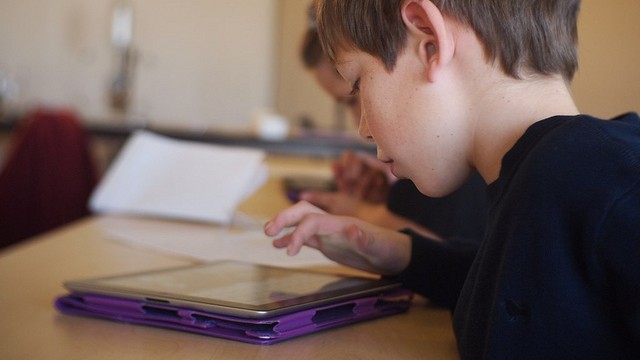"There are real advantages to print," he said. "You can write on the text right there," noting that if students aren't allowed to write in textbooks, they can use small sticky notes that come off easily. "You can also flip back and forth very easily, and spatially, there are advantages to print media."
Making those annotations in digital readers, like iPads and Chromebooks, can be more challenging than grabbing a pencil and sticky note.
When Pennington's seventh graders took the Smarter Balanced Assessment in English Language Arts on new Chromebooks last April, Pennington didn't teach them how to use the test's annotation feature. Students would have been able to highlight reading passages and take notes on the text to help them answer test questions. He thought it was too complicated for them to learn how to use well in time for the test.
"It was so cumbersome," he said. Students had to turn on the annotation feature, move back and forth between screens, remember the location of the notes, and then return to the questions they were trying to answer. He said for most of his students, it would have been tricky to "walk and chew gum at the same time," so he shelved it.
DRAWBACKS OF DEVICES...FOR NOW
While ever more schools adopt textbooks and student reading materials to digital readers like iPads and Chromebooks, some recent research suggests students may comprehend more from reading print. Middle school students who read from both print and e-books showed they understood more of what they read from the ink-and-paper books, according to one preliminary study presented by Heather Ruetschlin Schugar and Jordan T. Schugar of West Chester University.
Although tablets and touch devices allow readers to interact in innovative ways, the researchers wrote, "Reading comprehension research with multi-touch devices is still in its infancy and students will need to adapt new reading strategies in order to maximize their learning in this environment."
The Schugars have conducted two additional studies in which grade school students better understood material when not distracted by the bells and whistles of an interactive digital book. Annie Murphy Paul, in writing about the Schugars' work for the New York Times, wrote, "It seems that the very 'richness' of the multimedia environment that e-books provide — heralded as their advantage over printed books — may overwhelm children's limited working memory, leading them to lose the thread of the narrative or to process the meaning of the story less deeply."
For older students, the ability to take notes easily appears to be a big reason for choosing print textbooks over digital. In a Hewlett Packard online survey of 527 college students at San Jose State University, 57 percent of students who responded said they preferred print materials to e-books when studying. When citing reasons for their preference, 35 percent of print users cited "note-taking ability" as a reason for preferring print vs. six percent of those who favored e-books.
Yet those who study reading seem to understand that comprehending in the new medium may require some new training and practice to receive the full benefits. In a recent New Yorker article, Being a Better Online Reader, Maryanne Wolf, author of a history of reading called Proust and the Squid, said she's developing digital apps to help train students to deep read digitally. She cites a new study that showed fifth-graders became better digital readers after learning how to use the digital annotation feature.
"The same plasticity that allows us to form a reading circuit to begin with, and short-circuit the development of deep reading if we allow it, allows us to learn how to duplicate deep reading in a new environment," Wolf said in the article.
TEACHING NEW SKILLS
Maybe new note-taking skills require nothing more than a shift in perspective. In a recent MindShift article about a one-to-one iPad program, Hillview Middle Principal Erik Burmeister, said that annotating digital books gives his students a sense of freedom – a place to "dirty up" their materials with thoughts and ideas.
"In a traditional school environment, you're given a textbook and told not to write in it at all. And this is really counter-intuitive to what we want kids to be able to do in the real world," he said. "We want them to write all over the things that they're reading." Since allowing every kid to write on paper books would mean throwing away those books at the end of every year, the devices give kids the chance to annotate inside the document.
"It"s being able to engaged with the material in a really kinesthetic way," Burmeister said. "The material is so sacred that it's not sacred, you can really dirty it up."
So if engaged readers annotate, and students may or may not prefer taking notes in print books, what's next for the e-book? Where does it fit into school? What's the best use of an e-book for learning? More research will need to be done, especially on how students use the annotation features of e-books, to get a clearer picture of how well students can take notes and be able to find them on digital readers. Perhaps technology will improve, and annotation features will become more intuitive in the next generation of devices. And maybe parents and teachers will need to distinguish reading for fun on tablets, with the distracting bells and whistles, from reading for school, where material is less interactive but more straightforward for better absorption.
Mark Pennington believes that there will always be room for both print and digital reading in school. In the mean time, he will continue teaching kids how to annotate, because giving students the "ability to talk to the text, to create an internal dialogue with the text," is the best way to help students understand what they're reading. Whether that ends up being most effective tapped on a tablet or scribbled in the margins remains to be seen.


